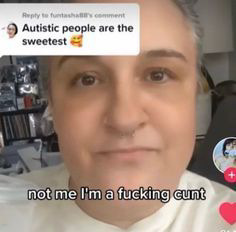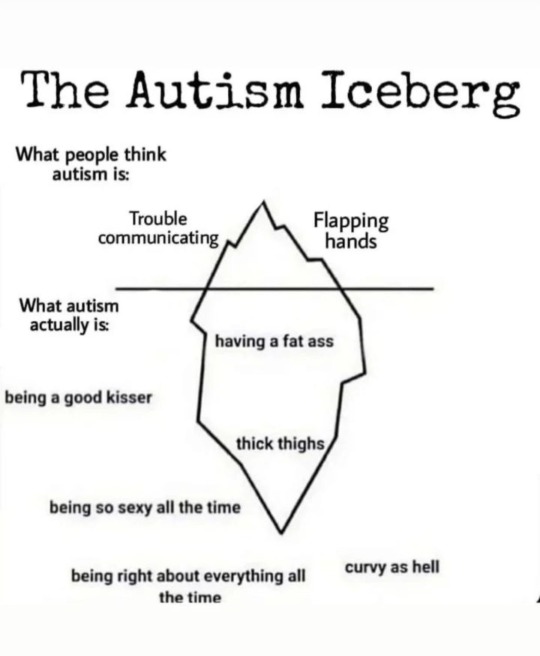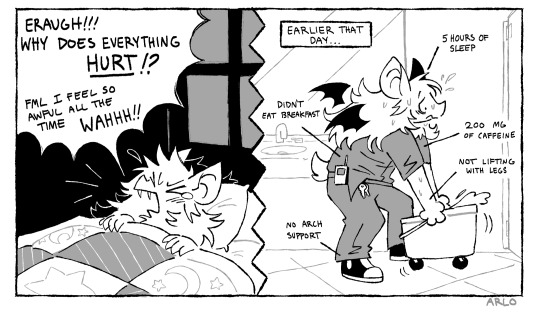Transmasc | 20s | He/Him | very bored and socially anxious | Dyke but occasionally interested in men 🤷♂️. Blog is sometimes 18+. but I try to keep my reblogs slightly more PG but it's not guaranteed.
Last active 4 hours ago
Don't wanna be here? Send us removal request.
Text
I do actually care marginally about the guy in that reddit screenshot who voted for Trump and is now worried that he might lose his medicaid funding because I did not fucking stutter when I said healthcare is a human right but the people losing their internships and job offers to the hiring freeze are straight up hilarious.
69K notes
·
View notes
Text
"Transandrophobia" Primer
There's a wild amount of misinformation about the term "transandrophobia" going around, and has been for a long time. So let's dig in a bit and set the record straight.
What it is
"Transandrophobia" was coined as an alternative to "transmisandry", and describes the unique oppression targeted at and faced by transmasculine folks (and people perceived to be transmasculine).
Transmascs experience oppression not just on the basis of being trans, or (typically) AFAB, and certainly not on the basis of being men alone. What we experience is unique to being transmasculine, and the way cissexist society categorizes and responds to us: not as women, not as men, but as an "other" that lies between the two.
Some quick examples of transandrophobia:
Trans men are the most likely group in the trans community to have negative experiences with healthcare providers.
AFAB trans people in general are most likely to be denied HRT.
Trans men are most likely to be denied surgery coverage.
Trans men are most likely to avoid healthcare out of fear.
Nonbinary people and trans men were most likely to report having never, or only sometimes, been treated with respect by law enforcement.
Trans men are more likely to experience problems with airport security.
Trans men are most likely to avoid public restrooms.
Over half of all AFAB nonbinary people and trans men experience sexual assault. These are the highest rates in the queer community.
9 out of every 10 trans men seriously consider attempting suicide. This is the highest rate in the queer community.
About half of all trans men attempt suicide. This is the highest rate in the queer community.
What it Looks Like
Transmascs are generally placed in one of two categories: confused "girls" they believe can be saved, and evil, dangerous "other" they believe are beyond saving. There's a ton of overlap in these two categories, both in what they experience, and in the fact that oftentimes the two are experienced simultaneously; even in the same situation.
A quick, incomplete list of how these things can manifest:
Infantilization ("soft", "little")
Removal of autonomy
Stereotyping as "whiny", "hysterical", or "entitled".
"Butch flight" or "ROGD" - the idea that transmascs are stealing butch lesbians.
Pressuring transmascs to be more feminine/womanly, either through overt force, or through subtler manipulation.
The desire to "make transmascs women" via sexual assault (corrective rape).
The idea that testosterone causes aggression; emotional, physical, and sexual- therefore transition is dangerous, and transmascs who transition are dangerous.
Fearmongering around transmasc transitions; "binders can never be safe", "vaginal atrophy is untreatable", "you'll get fat/ugly/acne/sweaty/oily/smelly", "phalloplasty is too dangerous/expensive/unsatisfying to be worth it", etc.
Medical professionals dissuading transmascs from transitioning; stressing risks that can in actuality be mitigated easily, nitpicking family history without presenting options, etc.
The idea that transmascs only become trans to "escape misogyny" or to "gain male privilege".
Erasure of transmasc experiences, esp. experiences with misogyny and transphobia.
Lack of resources for transmasc abuse survivors.
Lack of resources for transmascs in need of reproductive healthcare on the basis of "male" gender markers, names, voices, and appearances.
Why We Call it That
"Transandrophobia" can be broken down in two ways:
"Trans" + "androphobia" = the "trans version" of "androphobia", a fear of men or social bigotry toward men.
"Trans-andro" + "phobia" = a social bigotry directly specifically at trans men/transmascs.
The second is the more common interpretation and usage, largely because the first can be interpreted, by some, to mean that those using the word are suggesting that it's actually (cis) women who oppress (cis) men, that we don't believe patriarchy exists, etc. This, of course, has never been the intention of the word.
The first break-down above could also be interpreted to refer to patriarchy's negative stereotyping of men- as aggressive, dangerous, and sexually predatory.
While that doesn't translate to systemic oppression of cis men, those same feelings- a general disgust and fear toward the concept of manhood- do inform how society responds to transmascs. As a group of people who are oppressed on the basis of being transmasculine, those feelings do play a role in transmasc oppression.
What it Isn't
"Transandrophobia" is not an attack on, or accusation toward, any other group of people.
The word does not imply that trans women oppress trans men, that transmascs have it worse than anyone else, that transfems are horrible bigots, that transfem issues do not deserve the attention they receive (or, ideally, far more attention than they currently receive).
It does not imply that cis misandry exists, that "MRAs were right", that patriarchy and misogyny aren't real, or that feminism isn't necessary.
It does not signal bigotry toward other groups. Whatever your personal opinion of the word, of who uses it, or of who coined it, the word is a word and it stands alone from those things. It belongs to the transmasculine community.
It does not demand anyone pay any less attention to other important issues. It does not accuse other trans people of oppressing us. It does not dismiss the existence of patriarchy or structural oppression of women. It does not belong to any one individual.
Why We Need it
There are real, tangible issues within the transmasc community- things that are unique to transmascs- and those things happen because of a unique bigotry toward transmasculinity.
In order to address those problems, we have to be able to talk about what they are and why they happen.
In order to talk about that, we need a word for what it is. "Transandrophobia" is that word.
Don't get me wrong: the word might change at some point, and that's fine. If the transmasc community as a whole decides that we would like a new word, and creates one together that suits those new needs, that's fine. But as of now, this is the most common, recognizable, easy-to-understand word we have.
"Transandrophobia" belongs to the transmasc community, and it's up to transmascs to define, interpret, create or remove associations, revise, and replace, as it sees fit.
What You Can Do
If you're transmasc:
Talk about your experiences. Connect with other transmascs. Join transmasc community spaces, create new ones, and maintain a positive, productive, and inclusive culture within those spaces. Uplift transmascs with different experiences from you.
Be an ally to other trans people, to people of color, to disabled people, and to other marginalized groups. Do not allow resentment toward the trans community- any part of it, and especially toward transfems- to fester in any space you inhabit.
If you're not:
Listen to transmascs. Seek transmascs out to listen to. Uplift transmasc voices. Learn. Ask questions, even if they're scary, and be ready to be surprised by the answers.
Think for yourself. Own your opinions, and own where they're coming from; don't blame them on other trans people. Acknowledge your limitations in experience. Know that you don't need to understand in order to respect us. Try to understand anyway.
4K notes
·
View notes
Note
transandrophobia isn’t real simply because trans men are not oppressed by virtue of being “men”, they are oppressed for being trans
Hiii so you may have the wrong number (unless you’re sliding into everybody’s asks to spread the word) because I don’t believe I’ve posted anything on transandrophobia, since I am fairly new to the term. However I found this post incredibly informative and think everyone should read it (and the linked sources) very carefully.
I wholeheartedly believe that transandrophobia is real. (Sorry to disappoint, anon!) Firstly, since I am not transmasc myself, I strongly believe other LGBTQ+ folks when they describe their personal experiences. Secondly, as a brown, Muslim, deshi bisexual WLW I am intimately familiar the concept of a unique sort of phobia emerging due to an intersection of different phobias. The stats and issues cited rhyme eerily with those on high rates of mental illness, substance abuse, intimate partner violence, identity suppression, alienation/stereotyping (the cheating bisexual, that it’s just a phase, the androcentric desire hypothesis, etc) and lack of LGBTQ+ community support of bisexuals in comparison to monosexuals.
And, finally, I am passionate about sapphic culture/history, especially the effects of separatism. With the rise of second-wave feminist/TERF/puritanical/gold-star/gender essentialist/political lesbianism/biphobic culture in the 2020s, as a bisexual femme I have been deeply concerned about how this will affect butch, masc, non-binary, agender, genderqueer and transmasc sapphics—as well as trans men! Truly, there’s nobody that “centers men”—a term I have now come to despise—as much as folks who vehemently think of their hatred of men 24/7. I have no trouble believing trans men do face phobia and rejection from certain spaces due to being men, as well as due to being AFAB and trans. Generalised repulsion towards other humans is not healthy, nor does this binary thinking help collective women’s, men’s, and LGBTQ+ liberation from the patriarchy. It’s pretty obvious to me that we should all take transandrophobia really seriously in this climate, and protect transmascs alongside the dolls!
402 notes
·
View notes
Text


Wanted to draw this extremely cute 1930s postcard I stumbled across earlier
9K notes
·
View notes
Text













on being yourself
@ brainsoupp_ on twitter// @stmichaelthearchangel// @ cybermrcury on twitter// @throughmy-eyez // @ shellerina on twitter// @caesarsaladinn// @ nelsoncj4 on twitter // @ heimberg_a on twitter// make your own kind of music by cass elliot// @ soledadfrancis on twitter// ? // @ sourcenectar on twitter// @superorganism
15K notes
·
View notes
Text
i get that americans love their cultural imperialism, but it really does piss me off that june is “international” pride month just because something happened in the united states.
in aotearoa, june isn’t our pride, it’s theirs. marsha p johnson and sylvia rivera are their historical figures, not ours. the phrase that “you owe your rights to Black trans women” is true there, but here we owe our rights to (mostly) Māori historical figures. i have the freedoms i do because of the legacy of an entirely different set of people operating in an entirely different context at entirely different times.
But because of american cultural imperialism, most queer people in Aotearoa don’t even know our own queer history. Carmen Rupe, Ngahuia Te Awekotuku, the Dorian Society, Gillian Laundon, Georgina Beyer, and the Wolfenden Association are some of our queer history. We should know their names! we should know what they did for us! but because of the power of the american imperial machine, we don’t.
our national pride month should be july, the month that the Homosexual Law Reform Act passed in 1989. our two largest cities hold their pride festivals in february and march, respectively. american queer history has very little (or nothing, depending on who you ask) to do with our queer history. anecdotally, from my own queries, queer youth in aotearoa know more about american queer history than our own.
anyway, happy pride, americans. i’m truly sorry that most of you don’t see the negative impact your nation’s culture has on the rest of the world. and to the rest of the world reading this, try searching for your own country and culture’s queer history, don’t accept the american narratives as your own. we deserve our own histories divorced from the cultural hegemony of the USA.
39K notes
·
View notes
Text
i feel like we as a digital society have forgotten the important rules of the internet
Don't feed the trolls
Never give out personal information
Anonymity is the best defense
Don't click suspicious links
Don't click popups and ads
Just because it's written doesn't mean it's true
You are responsible for your own experience
There is porn of everything, act accordingly
63K notes
·
View notes
Text
Trans women I'm so glad you're alive today. Please never give up.
13K notes
·
View notes
Text
Bro, we are cooked. The knight that dogs the prince's shadow like a dark and silent wraith just knelt to press his forehead to the prince's hand. Yeah, now he's uttering a prayer whose recipient is ostensibly God but in reality is the deified version of the prince that exists only in his mind. Aaand the prince just caressed his cheek to preemptively grant him absolution. I gotta... I gotta get out of here.
#royalty kink#knight x prince#prince x knight#knightposting#knight kink#knightcore#uh oh! who wants to be my knight?#or be my prince
23K notes
·
View notes
Text
"im riding my biggest dildo imagining it's you" maybe use one of your medium sized dildos?
23K notes
·
View notes
Text
How to Make Your Own Binder that Fits Well and Looks Good
A while back I was in need of some new binders and thought hey, I bet I can make one way cheaper than buying it from somewhere (especially cus some of the ones I’ve bought in the past didn’t really fit right). Except when I started looking for a binder patterns online, I was very surprised that I really… couldn’t find many that looked very nice lol. Most of them had really wrinkled necklines, or didn't bind well, or just overall looked weird. A lot of the patterns also required a serger, which I don't have.
So I just said fuck it and made my own pattern! And it ended up being relatively easy! And the binders fit REALLY WELL and are comfortable to wear, even for long periods. The neckline doesn't show under shirts with loose collars, and the bottom hem doesn't gap or stick out. Here's me wearing one:
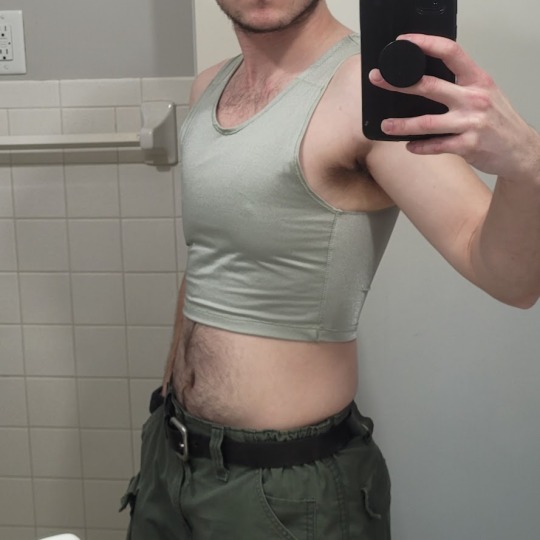
(plus I was able to make myself 5 of them for a total of like ~$50.)
So I figured I could throw together a guide to help out anyone else who wanted to make their own binder but was dissatisfied with the patterns available!
Disclaimer: This tutorial is going to assume a baseline level of sewing experience, and also will require access to a sewing machine. It is not a complicated pattern, but it will most likely require some tweaking and adjustments after you make the first one. Don’t be afraid to make alterations to make it fit better!
This tutorial is for a gc2b-style half-tank binder. It could be altered to be a full-tank binder, but all instructions will be for the half-tank design.
Materials needed:
Stretchy fabric, probably listed as 'athletic fabric' (I use this kind from Joann’s. Most athletic stretch fabrics should work, look for around 80% nylon/20% spandex blends)
Stiff fabric (I use this shirting cotton because I like how lightweight it is. If you want something a little stiffer with more structure, you can use a cotton or cotton/poly blend twill like this. gc2b binders use twill for theirs.)
Lightweight fusible interfacing (I use this kind) (get FUSIBLE not sew-in)
Fusible webbing like Pellon Wonder-Web (this is technically optional but it WILL make your life easier when you’re sewing - just make sure to get the kind with the paper backing!!!)
“But kiwisoap thats 4 whole kinds of materials, surely I don’t need that many!” Ok sure, you can probably get by without the fusible web and interfacing, but consider: they are both dirt cheap (im talking like $1-2/yard), they will make it much easier to sew the final product, and will give you an overall better-looking result. This tutorial is written with the assumption that you’ll use them.
"How much fabric will I need?" Measure the circumference of your chest below your armpits. Add 6 inches just to be safe. This is the yardage of stretch fabric you’ll need, and should give you enough material to make at least 3 binders without much excess left over. You will need around half as much stiff fabric.
Other supplies:
Big Paper (for drawing the pattern)
Flexible measuring tape
Sewing machine
Iron
Pins
Step 1: Measuring
You will need 4 main measurements for this pattern.

A) Measure the circumference of your chest just below your armpits, then divide the number in half. This will be the widest part of the pattern.
B) Measure from the top of your shoulder down to where you want the binder to end. For most folks, this will usually be around the natural waist (narrowest part of the torso), about 3-6 inches above the belly button. This will be the overall height of the pattern.
C) Measure the distance from below your armpit to where you want the binder to end. This will determine where the arm hole starts.
D) Measure the circumference of your waist where you want the binder to end, then divide the number in half.
So for example, after dividing A and D in half, my measurements are 17", 15", 7", and 14.5".
Next:
Subtract one inch from measurement A - This will help provide some compression. You might need to take it in even further depending on how it fits, but one inch is a safe starting point. I take mine in around 1.5 inches.
Subtract half an inch from measurement D. This will help prevent the bottom edge of the binder from gapping. Again, you may need to take it in more or less, depending on your own body.
Add 1.5 inches to measurement B and one inch to measurement C. This is to account for the hems and armhole placement.
This makes my final measurements
A = 16"
B = 16.5"
C = 8"
D = 13.5"
From here on out, we are only going to be working with the measurements that we have added/subtracted to, NOT the ones we initially took.
Step 2: Drawing the Pattern
You will need a piece of paper large enough to accommodate the entire pattern. This may involve taping multiple pieces together, or using a piece of newsprint, etc.
I recommend folding the paper in half to ensure that you get a symmetrical pattern. However, this means you will need to divide measurements A and D in half again, or else you’ll end up with a pattern that’s twice as wide as it should be!
Also note: the pattern is drawn with the seam allowance built in! You don’t need to add any seam allowance.
To draw the pattern:
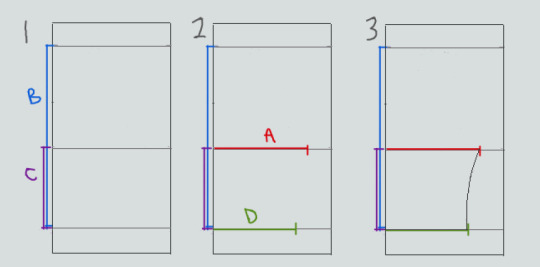
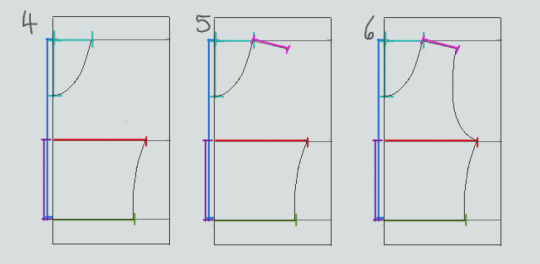
Begin with your folded paper. Measure and mark B and C on the paper, and draw a line extending across the paper. These will be your guidelines.
Measure and mark A and D along the middle and bottom guidelines, respectively. Remember, the paper is folded, so you only use half of the measurement for A and D.
Draw a loose curve connecting the endpoints of A and D. If needed, you can also just draw a straight line between the two.
Mark the opening for the neck hole. Depending on your size, it will measure around 6-8 inches across at the top (remember to divide this in half for the folded paper) and about 5-6.5 inches deep. (mine is 6.5" across and 5.5" deep) Draw a curve to connect the two points. This part will take some tweaking and adjusting to get it to look right lol.
Measure the width of the strap - this should be somewhere between 2.5 - 4 inches wide. They will end up about 1/2” to 3/4” narrower once you sew them. Draw the line at a slight angle, as shown.
Connect the endpoint of the strap to the endpoint of line A with a curve like in the diagram.
This will be the pattern for the front piece.
To make the back piece, trace the front pattern, but make a very shallow curve for the neckline instead of a steep one, as shown:
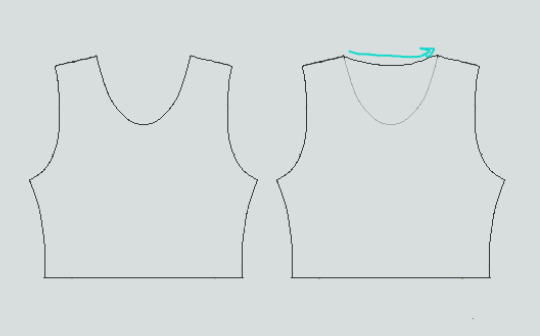
The last piece is the stiff front panel. This is what provides the flattening effect of the binder. To make the pattern, trace the front pattern again. Trim 3/8” in on the sleeves and neckline, and 3/4” to 1” along the bottom. This gives a flatter hem. Then trim the straps shorter by a few inches. This helps the binder lay flatter along the shoulders.
When you're done, you should have 3 pattern pieces that look approximately like this (stiff panel shown overlaid on the stretch fabric to show how it fits together).
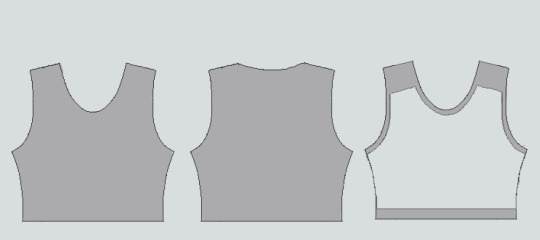
NOTE: If you want more compression or just want to make it a bit sturdier, you can add a second panel of stretch fabric to the back piece. Just use the bottom half of the back pattern (from the widest part down to the bottom hem) to cut out another piece of stretch fabric. Attach it to the back piece with a strip of fusible webbing and a zig-zag stitch along the top.
Step 3: Putting It All Together
Once you’ve made the patterns and cut out the pieces of fabric, you should have something that looks like this:
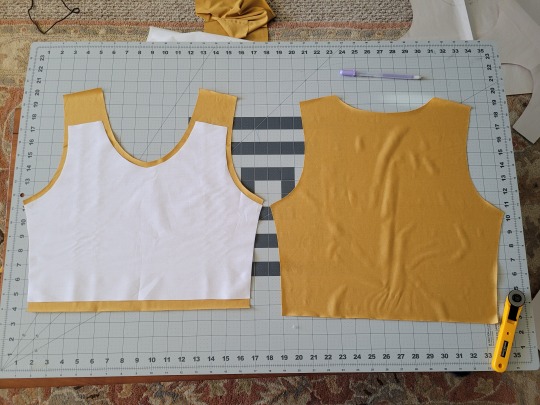
The next step is adding interfacing and fusible webbing. Use your pattern to cut out 3/8" strips to fit on the top of the straps for both pieces, and to the neckline, sleeves, and bottom hem of the back piece, as shown:
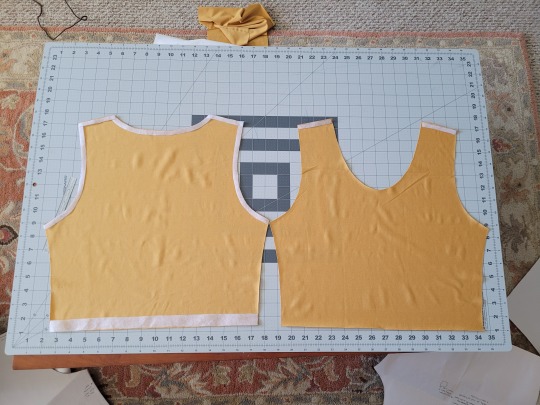
If you want to add it to the bottom hem of the front piece, it will help keep that hem flat when sewing it down later, but it's not essential.
If you choose to also use fusible webbing (WHICH I RECOMMEND), you will apply it to the stiff front panel similarly to how the interfacing was applied, ~3/8” strips along the neckline, sleeves, and top of the straps. Cut out two strips for the neckline and sleeves, because we'll use those later too.
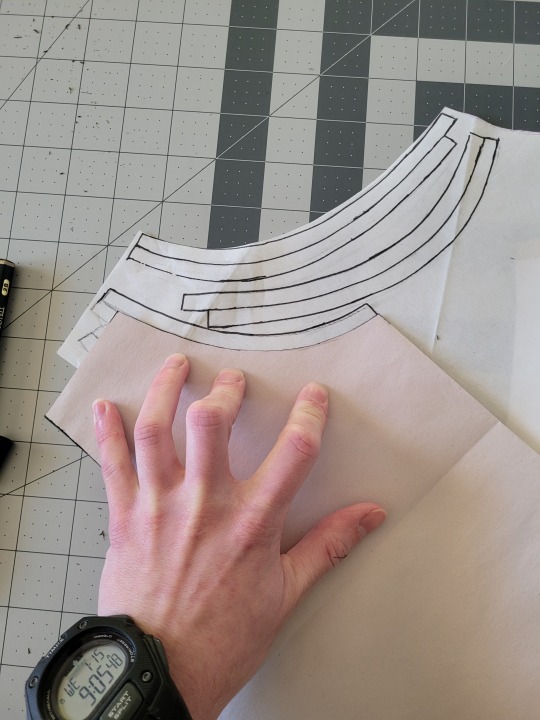
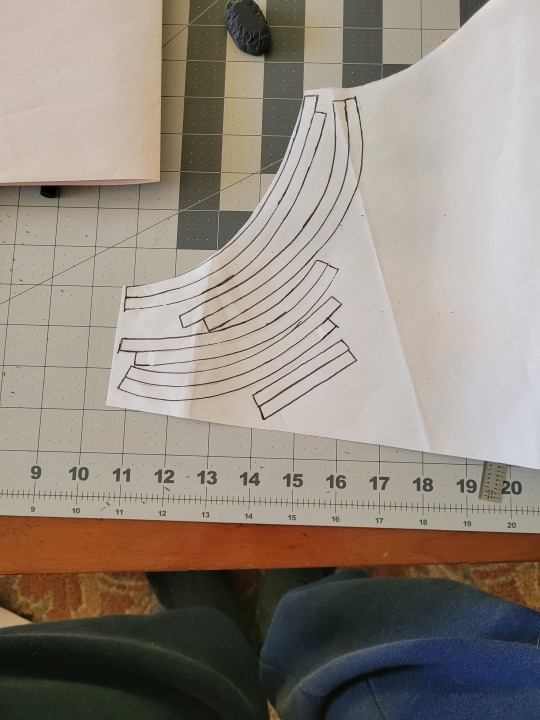
Iron the strips onto the front panel as shown:
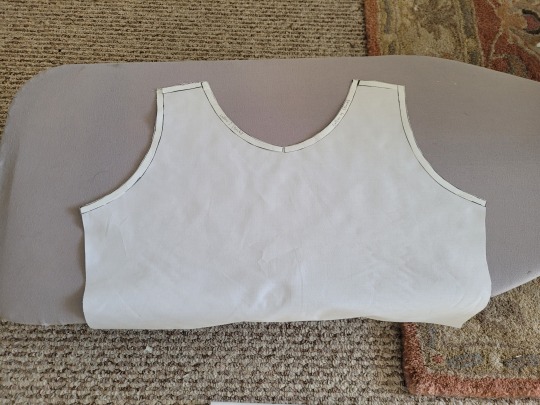
Once it's on, just peel off the paper, position it webbing-side down on the stretch fabric, and iron it to fuse the two pieces together so everything stays in place while you sew. THIS MAKES IT WAY EASIER TO SEW.

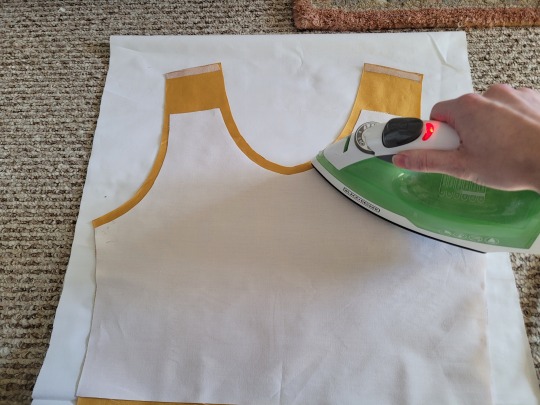
After the stiff front panel is fused to the stretch fabric, you’ll sew the straps of the front and back pieces together, then join the pieces along the sides. Pin the hell out of it to keep everything in place -this type of material is VERY prone to puckering.
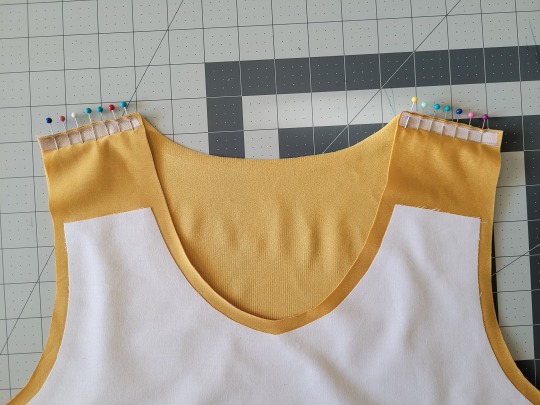
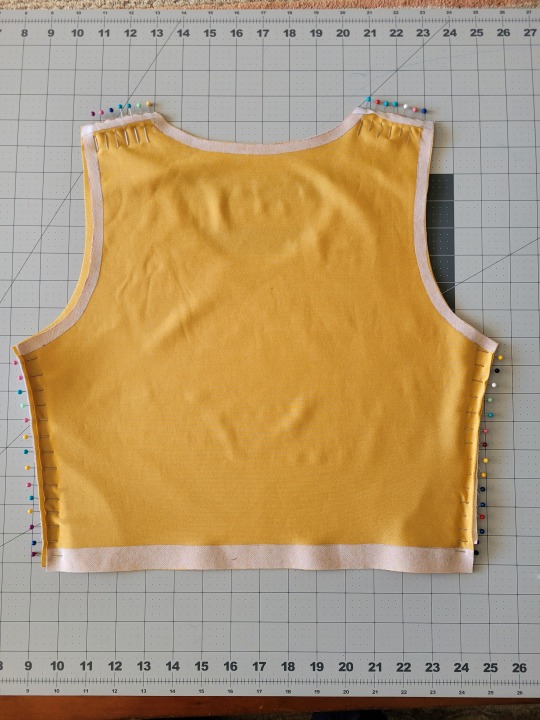
When sewing, USE A ZIGZAG STITCH. A straight stitch will NOT WORK for stretch fabric. I adjust mine to 1.3mm long and 3.5mm wide which has worked well. If your machine doesn’t let you adjust stitch length or width, well. That sucks, I don’t really have any advice.
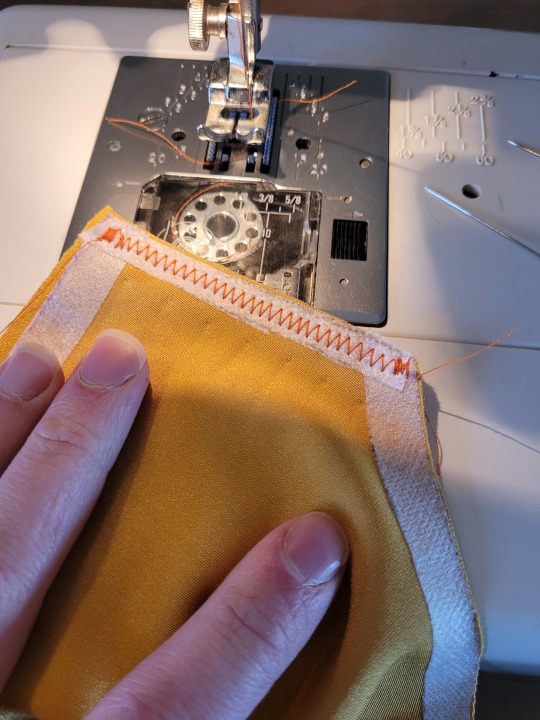
After you sew the front and back pieces together, you can add more fusible webbing to the front panel to help hold the hem down flat and prevent it from puckering while you sew it. Just add the strip, peel the paper off, then fold the hem over and iron it down. This part isn’t really necessary, but it does make the hems look nicer. If nothing else, I would recommend adding it to the neckline.
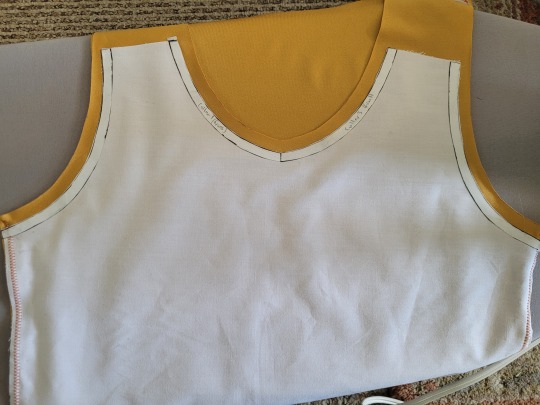
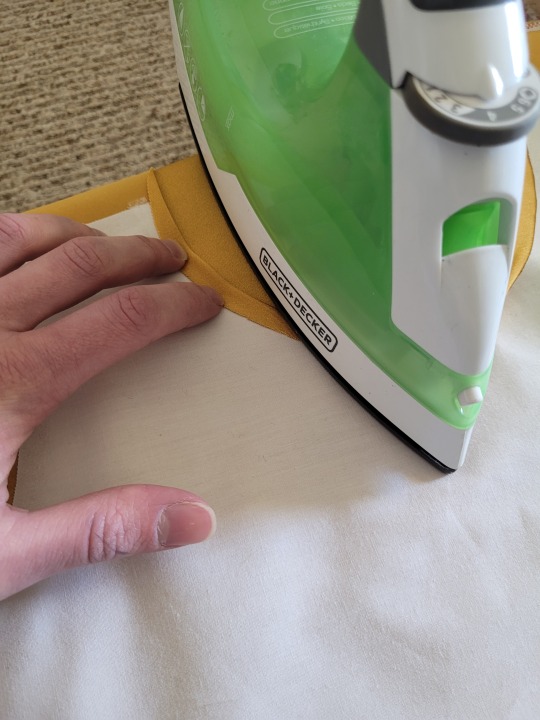
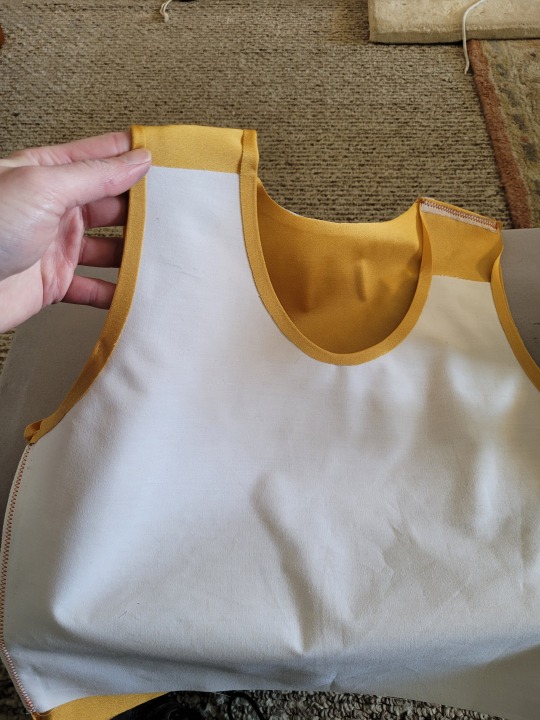
After that, you just fold & pin all the hems and sew them up with a zigzag stitch, then go over the raw edge at the top of the stiff panel (where we cut the straps shorter).
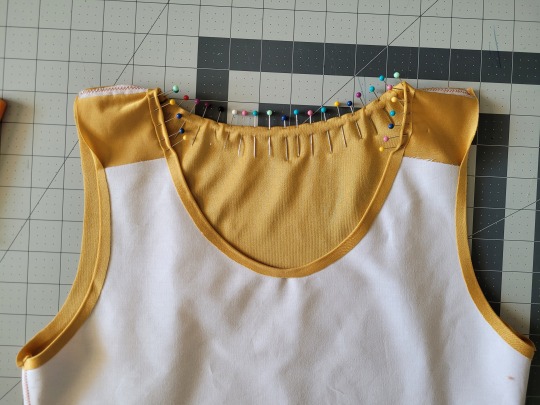
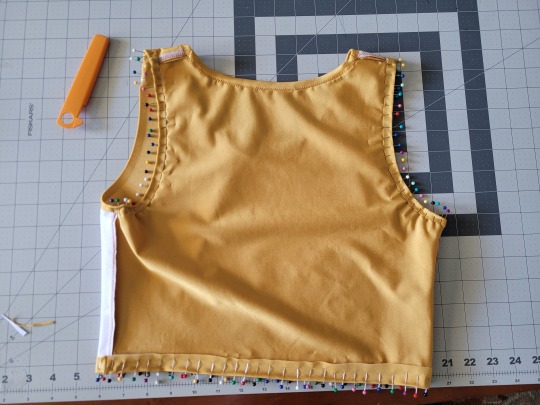
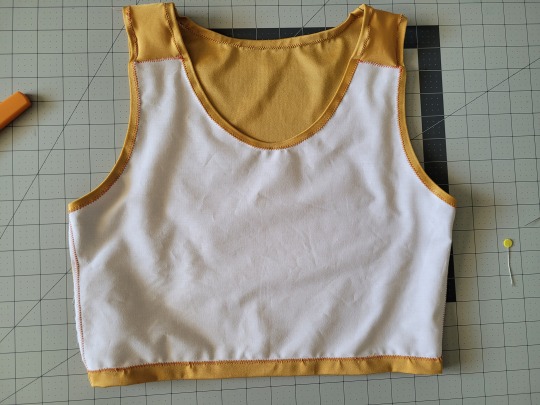
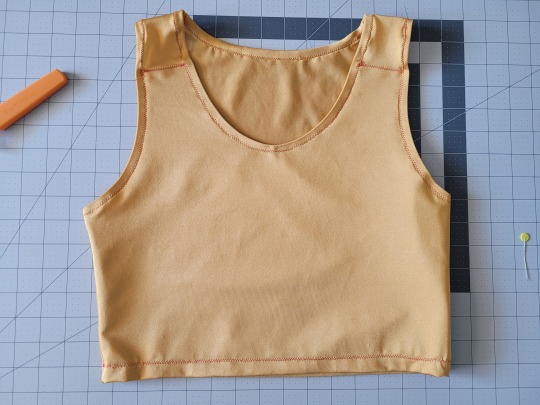
And that’s it! You’re done! And now you can make your own binders whenever you want!
And hey! If you used this tutorial and wanna throw me a dollar or two on ko-fi, I wouldn't complain.
2K notes
·
View notes





